Sugar is one of the most dangerous ingredients on the market. It’s addictive, added to almost every processed food, and will make you overweight, depressed and sick if you eat too much. In fact, Americans eat close to 130 pounds of the stuff per person per year (4 times more than the recommended daily allowance), likely because it is so addictive. That’s why it’s exciting to know there are alternative sweeteners made in nature, like “stevia,” that don’t wreak havoc on your health – or do they? Is Stevia safe? That’s what I went on a quest to find out. Here’s what happened…
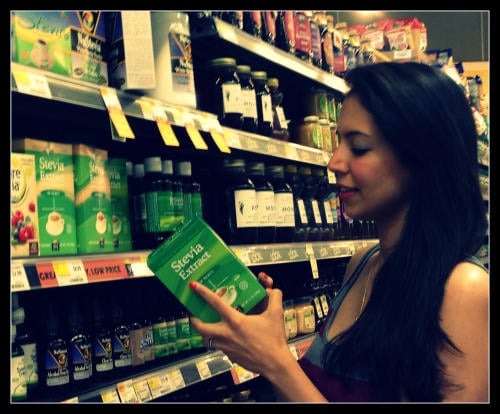
What Is Stevia?

For those of you that are hearing about stevia for the first time, it is a plant that is typically grown in South America, and while its extract is 200 times sweeter than sugar, it does not raise blood insulin levels. That’s what makes it so popular. However in 1991 the FDA refused to approve this substance for use due to pressure from makers of artificial sweeteners like Sweet n’ Low and Equal (a one billion dollar industry). But in 2008, the FDA approved the use of rebaudioside compounds that were derived from the stevia plant by Coca-Cola (Cargill) and PepsiCo – hmmm doesn’t that sound suspicious? Not until a major food company got involved did stevia become legal, and only after it had been highly processed using a patentable chemical-laden process…so processed that Truvia (Coca-Cola’s branded product) goes through about 40 steps to process the extract from the leaf, relying on chemicals like acetone, methanol, ethanol, acetonitrile, and isopropanol. Some of these chemicals are known carcinogens (substances that cause cancer), and none of those ingredients sound like real food, do they?
The whole leaf stevia that you can grow in your backyard (and has been used for centuries in countries like Brazil and Paraguay) remains a non-approved food additive by the FDA. However, rebaudioside A (the stevia extract) that was approved by the FDA has not been used for centuries and long term human health impacts have not been studied and are still unknown. The sweetener/sugar industry wields powerful influence over what is ultimately approved at the FDA, and this is just another example where they are influencing decisions that don’t make sense. How can a chemically derived extract be deemed safe in processed food and a plant from mother nature not?
What Kind Of Stevia To Avoid
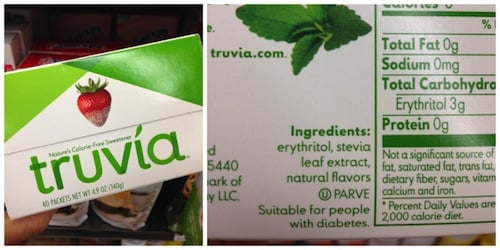
The 40-step patented process used to make Truvia should make you want to steer clear of this stevia product alone, but there are two other concerning ingredients added (not only to Truvia but other stevia products as well). First, erythritol is a naturally occurring sugar that is sometimes found in fruit, but food manufacturers don’t actually use the natural stuff. Instead they start with genetically engineered corn and then go through a complex fermentation process to come up with chemically pure erythritol. Check out the manufacturing process below:
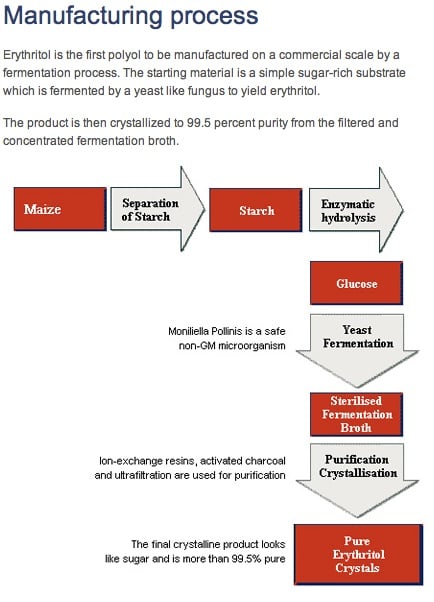
Credit: Cargill

“Natural flavors” is another ingredient added to powdered and liquid stevia products, likely due to the fact that once the stevia leaf is processed it can develop a metallic taste. Manufactured natural flavor is contributing to what David Kessler (former head of the FDA) calls a “food carnival” in your mouth. This makes it difficult to stop eating or drinking because the flavors they have synthesized will trick your mind into wanting more and more. When companies use manufactured flavor, they are literally “hijacking” your taste buds one-by-one; that’s why I recommend putting products that contain “natural flavors” back on the shelf.
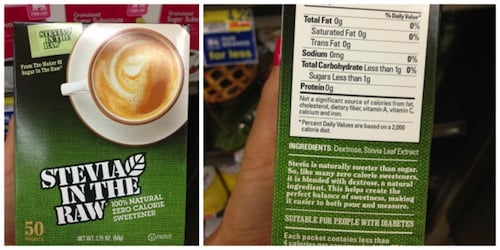
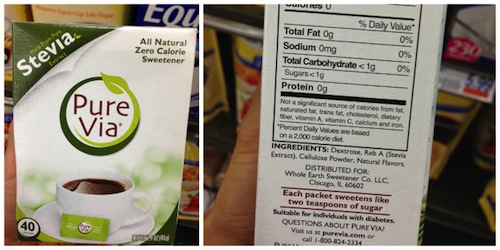
“Stevia in the Raw” sounds pure and natural, but when you look at the ingredients the first thing on the label is “dextrose” – so it’s certainly not just stevia in the raw. And Pepsi Co’s “Pure Via,” also pictured above, isn’t exactly pure either with this ingredient being first on the label, too. Dextrose is a sweetener that’s also derived from genetically engineered corn and has a long complicated manufacturing process, just like erythritol.
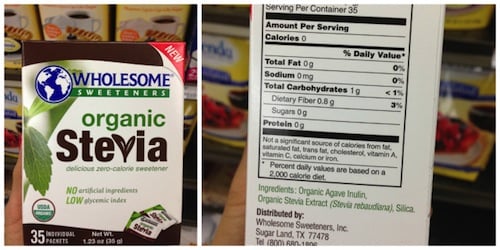

Even certified organic stevia can have sneaky ingredients added, like this one above which has more organic agave inulin than the stevia extract itself. Agave inulin is a highly processed fiber derivative from the blue agave plant. Also on the ingredient list is an item you are probably familiar with from those little packets sometimes found in boxed goods – silica (pictured). It is added to improve the flow of powdery substances and is the same ingredient that helps strengthen concrete and creates glass bottles and windowpanes. It may cause irritation of the digestive tract (if eaten) and irritation of the respiratory tract (if accidentally inhaled). While it is non-toxic and probably won’t kill you in small quantities, it’s definitely not a real food ingredient I would cook with or that I want to be putting in my body.
How To Choose The Right Kind Of Stevia
Luckily there are ways to enjoy this sweet leaf closer to it’s natural state… because let’s be honest, the no-calorie artificial sweeteners out there are really dreadful, and no one should consume them (check this post for the low down on those). So here’s what you can do:
- Buy a stevia plant for your garden (luckily it’s totally legal!) or purchase the pure dried leaves online – you can grind up them up using a spice grinder (or use a mortar and pestle) for your own powdered stevia.
- When choosing products already sweetened with stevia, look for “whole leaf stevia” on the ingredient label. For example one of my favorite protein powders is made with “whole stevia leaf” instead of rebaudioside a or stevia extract.
- Add fresh or dried leaves directly to tea or drinks for natural sweetness (note the straight stevia leaves are only 30-40 times sweeter than sugar, vs. 200 times using the extract).
- Make your own liquid stevia extract (see graphic below for recipe).

- If you are not up for getting a stevia plant of your own or making your own extract, remember to look for a stevia extract that is 100% pure without added ingredients (Sweet Leaf & Trader Joe’s have versions).
And when all else fails, choose a suitable alternative and forget stevia altogether. Use honey, pure maple syrup, or I personally prefer coconut palm sugar, since it is low glycemic (making it more diabetic friendly) and one of the most natural unprocessed forms of sugar available. It is naturally high in amino acids – has 10,000 times more potassium, 20 times more magnesium and 20 times more iron than conventional sugar. I use it all the time in my baking, from pound cake to muffins to a recent delicious cookie that is low in sugar – check out all those recipes here!
If you know someone who uses artificial sweeteners or stevia, please share this post with them.
Wishing you the best health life has to offer,
Food Babe




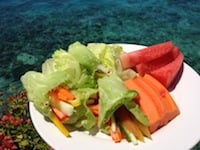
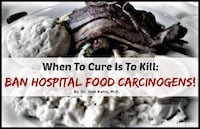


Thank you so much for doing this research into how stevia is made. When you talk about the extraction process of stevia, you mention that they use chemicals, specifically ethanol. If ethanol is bad than why do you prescribe vodka in the homemade recipe when vodka is just ethanol and water?
yeah why??
At no point though does it say Ethanol is bad, but erythritol and the use of GMO corn to get it to that stage.
Look at step 5, “To remove alcohol”
You can use vodka that is made from Non-GMO ingredients…I’ve been looking for some to make vanilla extract…I have found some that are Non-GMO & gluten/grain free….it’s not as common but there are some vodka’s made from grapes & potatoes…
I am curious about which ones are safe? I always bought the larger jar with the brown lid at trader joes, and it says the only other ingredient is lactose? Please advise. They have another small one also in powder form. Which is better?
Thanks!
How about xylitol derived from birch from the U.S? Is it safe?
“The idea, nurtured in Finland, of xylitol as birch sugar is incorrect. The precursor d-xylose can be extracted from birch, but it can come from other hardwoods, and also from maize, for instance.”
It is very expensive, thus a GMO crop. look it up on the net. this was from a student in Finland’s research. I was shocked at all the GMO products from vitamins to perfumes!
Hi,
Please check out this website. This is the best stevia that you will find.
Adam Schuh
CEO
Natures Stevia
Is this one safe to use?
http://www.greenpolkadotbox.com/organic-spoonable-stevia.html
Well Manny,
This is from their website:
Ingredients
Organic Agave Inulin, Organic Stevia Extract (Stevia Rebaudiana), Silica. Product of South America.
I would check out this site https://naturesstevia.com/product-category/unflavored
This would be my choice.
My son has fructose malabsorption so most sweeteners are a fail for us. He can’t have anything ending in -OL so no xylitol, no honey, and coconut sugar only in very small amounts. We use the liquid Stevia in the small dropper bottle from TJ’s and I use Skinny Girl Organics powdered Stevia in my coffee.
In the “How To Choose The Right Kind Of Stevia” section of this article, the link
” (check this post for the low down on those)”.. did not work for me. if you are having the same problem, here’s a different link to the mentioned post:
https://foodbabe.com/2013/01/25/coca-colas-low-calorie-beverages-will-kill-you-before-they-solve-obesity/
Years ago, I read that stevia can have negative effects on male reproductive organs. Since then, I have not seen anything about it and stevia has become hugely popular. Any thoughts? Did you see anything in your research?
Help! I’m a sweet ahollic. (Spelling). What can I use?
http://www.amazon.com/gp/product/B003WO0I6C/ref=as_li_qf_sp_asin_il_tl?ie=UTF8&camp=1789&creative=9325&creativeASIN=B003WO0I6C&linkCode=as2&tag=foobab-20
~ MONK FRUIT in the raw ~ is it safe ?! ~ (I hope so) ~ Is there ANYTHING I can just buy off the shelf ~ I don’t see myself growing and making my own sweeteners ~
I would like to know about Monk Fruit too.
I’m still reeling over the Splenda latest news, which I quit using and having withdrawls lol
Hi there! Great article. I’ve been using stevia years ago. Just got whatever is available on sheves and never stop to think on the whole process. I thought was good for me, at least better than sugar.
I have a question for you; how about raw sugar as direct stract fron sugar cane? Is also that bad? In south america is call “panela” which is the result of the extraction of the sugat cane juice, boilded and made all by farmers hands eith no chrmicals or additives… Is that ok???
You are making me a bit less able to trust you now. Those packs are NOT there to make it “taste better” – they are there to absorb moisture. Actually a healthy food will absorb moisture quicker – and that little pack of beads is there to keep it free flowing – powder. Unhealthy ones don’t need it – they have enough chemicals to keep them free flowing. Is that package healthy to eat? NO. But it is a padding put in place to keep the other ingredients from NEEDING chemicals to be dry.
Stevia in the garden is hard to grow. I planted HUNDREDS this last summer – I spent a fortune in seeds – from multiple companies – some certified organic, some local. That stuff doesn’t grow easily here.
And as far as I am concerned – the “raw” stevia they sell in the grocery is a lot easier on my stomach than Equal or Sweet and Low. I may not think it is perfect – but it is better than contaminated sugar or chemicals. There are three brands I trust and that let my stomach okay…
She’s saying those same packs for absorption the actual ingredient Silica, is what is in the sugar product, and you shouldn’t eat that stuff. She’s just putting the picture so you know that is the same thing. What’s not to trust??
Nothing is said about silica making a product “taste better” only that “It is added to improve the flow of powdery substances”, flow, not flavor. And yes, you are correct that the packets of silica are added to absorb moisture, also included in many pre-packaged medications such as pills and capsules, to absorb any moisture.
As I read it, she wasn’t saying a PACKET of the silica is in that brand of Stevia (as seen in a new pair of shoes or purse), but silica OUTSIDE of any packet distributed throughout the product itself. And as you say yourself, THAT is unhealthy to eat.
How far north or west (dry) are you? I put one stevia plant out in container and enjoyed the fresh leaf very much. I harvested seed, but in researching while writing this comment I read that self pollinated seed from single cultivars of stevia are sterile. The sources I read stated at least two distinct varieties are needed to produce fertile seed. That contradicts my own horticultural experience, but I have only started diversifying from traditional garden plants the past several years. I may dig those seed out from last years harvest seed stock and try germinating a dozen or so.
I have KAL brand Pure Stevia which has no other ingredients.
That’s what I have too , BUT the’ve changed the formula. . They’ve now added a filler to it. Check it out
I wish you would investigate and report on the manufacturing processes to make nutritional yeast. So many “health” professionals endorse it’s use & I’ve read articles that it’s equivalent to ingesting straight MSG.
Nutritional yeast is not the same as MSG. You may be thinking of autolyzed yeast extract which is one of the names given to MSG.
Any and all Stevia, regardless of purity or process, gives me a migraine. Almost immediately. The only other thing that works that quickly to make me sick is MSG, and that only in large quantities. Of course this is only anecdotal evidence, but I can’t be alone. Stevia is NOT safe for me.
Yes thank you! I thought I was the only one. I was getting sudden migraine headaches for the first time in my life and I traced it to the aquafina vitamin water I had recently started drinking. the regular version of it uses regular sugar but the aquafina 10 cal uses stevia and the headaches it produces are unlike anything I’ve ever had in my life. I’ll be staying away.
Coconut sugar is still sugar – which by it’s make-up has fructose in it. Yes it may be less than table sugar but it is only slightly less bad than table sugar and should not be consumed daily especially by diabetics! My son is type 1 diabetic and other “health gurus” have said diabetics can eat honey which absolutely absurd and puts their health at risk! There are good things about honey, coconut sugar etc – I do like the info you give but unless you are extremely familiar with a disease please don’t include them in your suggestions – just stick to your research and you will sound more credible.
I’ve Read That Coconut sugar Cannot Be sustainably produced and Is terrible For The Environment….
Every word after your last hyphen seems unnecessary. Let us all just stick to trying to help educate each other without putting someone down.
to layla
Giving info that a person with diabetes should have it, is not educational – it’s wrong. I actually complemented her after my last hyphen – she is very good at giving great info. I am asking she not comment on disease she may not know much about beyond the basics. I appreciate a lot of her info and I am glad she has this website – I am actually trying to educate her. Just because someone has a blog does not mean they are an expert on everything – someone can always learn something new. Considering some of the comments on here – this is the least insulting – I encourage her to keep going!
Thanks Debbie for sharing about diabetes. I am a recently-diagnosed adult type 1 and learning a lot. The poor info about “good sugars” by people who do not understand diabetes is common. As a general rule all sugars are equally bad for a type 1 diabetic. This may not apply for type 2; insulin resistance is a very different disease then not having any insulin.
Thanks Karen -your comments were well said! I didn’t mean any harm – I guess my defenses go up when it may affect kids or adults with disease!
I use NuNaturals Stevia – both liquid and powdered. It has no bitter taste, and has no additives.
In regards to dextrose/glucose as long as it’s made from non-gmo corn it’s actually the best sweetner. It is used by every cell in your body. However, i believe it’s a 3:1 ratio when compared to sugar, so you need a little more for whatever you’re naking to be sweet.
I use NuNaturals liquid Stevia, have for years. I get it at Sprouts. Ingredients are:NuStevia extract, water, pure grain alcohol, vegetable glycerine…
I just bought some Sweet Leaf chocolate Stevia drops — so relieved it “made the cut.” I will try growing a Stevia plant this summer, though, although ultimately I need to try to wean myself off the sweet stuff. I read an article that said even artificial sweeteners trigger your brain that something sweet is coming, so it sends a message to your pancreas to make more insulin.
Sweet Leaf was not mentioned, and is a safe Stevia choice. I believe it contains, inulin, and stevia, is organic and non GMO.
Thank you for all the work you do.
Happy New Year! ^_^
It was mentioned down at the bottom but it has unulin in it, not agave but vegetable, does that matter?
Thank you, thank you, thank you! I have begun to be more ‘On Notice’ of the items I am buying, that go into my body. By no means am I the slightest bit close to be organic, but I want to be the one that chooses if a GMO is put in my mouth. Not the manufacturer who doesn’t HAVE to label it for the consumer.
This information you give me about Stevia is ‘Just what the Doctor ordered’!
I am not a Stevia fan at all & I’m not happy that it is in a lot of natural food products especially protein drinks or meal replacement drinks
You may have an allergy. I get headaches from pineapple. It doesn’t mean pineapples are unsafe..just not good for me:(
Silica is not bad for you, it is actually good for you. I take it daily along with tons of people and have only benefited from it. Please do your research!
What Does Silica (diatomeaceous earth) Do for Your Body?
This mineral, which is the most abundant mineral in your body, acts as the stabilizing force in your body. It helps to restore the balance which is necessary between magnesium and calcium. If you did not have this balance you would be experiencing hormonal problems. Silica also stabilizes a lot of different structures, which includes bodily tissues, arterial walls and membranes. Your body will also use this mineral to form collagen, which is the protein that is responsible for keeping your skin from developing wrinkles. Maybe most importantly, silica allows your body to absorb calcium, which will help you to have healthy and strong bones.
Checkout the website for more information.
Agreed, the story conflates silica (which is part of many plants, including all grasses, and which you consume nearly every time you eat any kind of plant because it’s dirt) with silica gel, a manufactured product. Two different things entirely.
What Food Grade Diatomaceous Earth Does In Your Body
Diatomaceous EarthThis page explains the mechanisms of Food Grade Diatomaceous Earth within the human body to achieve the many health benefits that consumers have experienced. (See our our Human Use page).
Diatomaceous Earth Health Benefits: Why and How
1) As you can see from the picture of Diatomaceous Earth – (magnified 7000 times) – it looks like a cylinder full of holes – kind of like Rice Chex Cereal. This cylinder has a very strong negative charge. As these millions of cylinders move through the stomach and digestive tract, they attract and absorb fungi, protozoa, viruses, endotoxins, pesticides, and drug residues, E.coli, and heavy metals. These are trapped inside the cylinder and passed out of the body. In addition, any larger parasites that happen to be in the stomach or digestive tract are “cut up” and killed by the sharp edges of the Diatomaceous Earth. All of these activities result in a much healthier body with less sickness. We often hear the phrase “I just feel better” with our Diatomaceous Earth users. This better feeling comes from all the “junk” being removed from the body and by giving the immune system the “jump start” it needs.
2) Diatomaceous Earth is quite hard. On the hardness scale where diamonds are a 9, Diatomaceous Earth is a 7. This is very important because as those millions of tiny hard and sharp Diatomaceous Earth cylinders pass through the small and large intestines, they “scrub” the walls. After only a few months of taking Diatomaceous Earth, the intestine wall is no longer coated with mucus and molds but CLEAN!! The advantages of this are several:
Regular bowel movements (This is the #1 comment everyone makes about DE.)
Healthier colon. This is especially important as we get older. A clean healthy colon keeps away polyps, cancers, and ulcers. Today, many are spending thousands of dollars to get colonics to do the same thing as Diatomaceous Earth does.
Many users report increased energy and needing less sleep. This is a result of all the food and nutrients that are taken in being better absorbed into the blood stream. With a coated colon–many nutrients never get absorbed.
3) A small amount of Diatomaceous Earth gets absorbed into the blood stream as silica. One of the benefits of Silica is that it helps to destroy bad fats. Everyone we know who takes Diatomaceous Earth has lowered their cholesterol by 40-50 points, and they are amazed at how their high blood pressure goes down. Go to the page on “Human Use” and review all of the benefits of silica to the body.
Sore joints and ligaments feel better
Skin clears up (acne-age spots-psoriasis)
Hair and nails are stronger and grow faster
Stronger teeth and gums
Healthier respiratory tract–less coughing
Menopause has less symptoms
Healthier urinary tract
What Food Grade Diatomaceous Earth Does In Your Body
Diatomaceous Earth Health Benefits: Why and How
1) As you can see from the picture of Diatomaceous Earth – (magnified 7000 times) – it looks like a cylinder full of holes – kind of like Rice Chex Cereal. This cylinder has a very strong negative charge. As these millions of cylinders move through the stomach and digestive tract, they attract and absorb fungi, protozoa, viruses, endotoxins, pesticides, and drug residues, E.coli, and heavy metals. These are trapped inside the cylinder and passed out of the body. In addition, any larger parasites that happen to be in the stomach or digestive tract are “cut up” and killed by the sharp edges of the Diatomaceous Earth. All of these activities result in a much healthier body with less sickness. We often hear the phrase “I just feel better” with our Diatomaceous Earth users. This better feeling comes from all the “junk” being removed from the body and by giving the immune system the “jump start” it needs.
2) Diatomaceous Earth is quite hard. On the hardness scale where diamonds are a 9, Diatomaceous Earth is a 7. This is very important because as those millions of tiny hard and sharp Diatomaceous Earth cylinders pass through the small and large intestines, they “scrub” the walls. After only a few months of taking Diatomaceous Earth, the intestine wall is no longer coated with mucus and molds but CLEAN!! The advantages of this are several:
Regular bowel movements (This is the #1 comment everyone makes about DE.)
Healthier colon. This is especially important as we get older. A clean healthy colon keeps away polyps, cancers, and ulcers. Today, many are spending thousands of dollars to get colonics to do the same thing as Diatomaceous Earth does.
Many users report increased energy and needing less sleep. This is a result of all the food and nutrients that are taken in being better absorbed into the blood stream. With a coated colon–many nutrients never get absorbed.
3) A small amount of Diatomaceous Earth gets absorbed into the blood stream as silica. One of the benefits of Silica is that it helps to destroy bad fats. Everyone we know who takes Diatomaceous Earth has lowered their cholesterol by 40-50 points, and they are amazed at how their high blood pressure goes down. Go to the page on “Human Use” and review all of the benefits of silica to the body.
Sore joints and ligaments feel better
Skin clears up (acne-age spots-psoriasis)
Hair and nails are stronger and grow faster
Stronger teeth and gums
Healthier respiratory tract–less coughing
Menopause has less symptoms
Healthier urinary tract
Check out the website for more information.
I use only PURE RAW from Earth shift products and it is great tasting… I too have found all the additives in the stevia ad won’t buy it. I also use organic sugar from time to time and coconut palm sugar and honey… I believe all organic in moderation…
Great information. I first found Stevia at Whole Foods Market years ago. Since then, the manufacturers have adulterated it so much it is not really safe unless you really read the list of ingredients. Your article does a great job of letting the public know how devious the food industry can be. I would love to grow my own.
Great information. I use NOW brand pure Stevia extract. For anyone using this product regularly it can be bought in bulk. If you have a locally owned Health Food Store Pure Stevia Extract can be bought in bulk at a small percentage per ounce for what it costs for a small bottle. Or you can go on line and type in NOW Pure Stevia, Bulk purchase. I have no affiliation with the company. But as a Traditiional Naturpath I read lables ,stick to “pure” natural products; and any word in the ingredient list I do not recognize I research it. Corporations and government WATCHDOGS cannot be trusted to have our best interests as their first responsibility. That’s coward speak for, “They don’t care about our health only profits and their masters are Big Petro/Big Pharma/Big conventional medicine. I’m old enoughto remember the huge billboard posters in grocery stores proclaiming, ” MORE DOCTORS SMOKE BLACK CATS…….”, along with a picture of genial appearing man wearing lab coat and a stethoscope around his neck. “You’ve come a long way, baby.” “Sodium Fluoride a safe tooth decay preventative”. To quote T C Fry, experts in launching the BIG LIE MACHINE.
I have SweetLeaf Sweet Drops (both regular and Vanilka Creme), and on the regular one the ingredients are Purified Water, Organic Stevia Leaf Extract, and natural flavors. It’s the “natural flavors” that’s got me concerned. Is this product OK?
I think the Sweet Leaf is a reasonable choice, although, in the future I may try the “now” brand recommended by one of our own. The natural is always a cover up for fake flavoring. If you buy the straight Sweet Leaf, only inulin is present.
from Wikipedia
Inulin is a natural storage carbohydrate presenting in more than 36,000 species of plants including wheat, onion, bananas, garlic, asparagus, and chicory. For these plants, inulin is used for reserving energy as well as regulating cold resistance. It is osmotically active for it is soluble in water………. helps the plant survive a range of temperature.
I think variety is the way to go with sweeteners, and the less of them we use, the better. ^_^
I think the demonization of silica is incorrect. Look it up!
I read somewhere that Stevia was a form of ragweed. Anybody else heard this? I can’t find the article now, but anyone with allergies to ragweed would definitely want to avoid it if it is.
Allison, someone who’s allergic to ragweed may not be allergic to all the plants under that label (though they are certainly suspect).
What can you tell me about the Member’s Mark Stevia sold in Sam’s Club? It’s not considered a food item and therefore found in the pharmacy section. 200 packets at a great price, but what am I purchasing?
Stevia is a great thing.
I am assuming the same concept of over-processing applies to xylitol?
I have been using Stevia for years in liquid form. It was sold as a supplement. Mostly because the reasons you stated in your research. I have used some of the new powdered versions, but new thet we’re not as good. I recommend this brand. Sunrider. I have seen manufacturing first hand and the company has been making the best quality food grade herbs and supplements for over 30 years. Not sold in stores but independent distributors and online.
I have a stevia plant in a pot in the backyard and my kids love to pick leaves and eat them. I also puree the leaves in desserts. Honey is also a great sweetener. If used daily, honey increases iron levels by 20%, it is anti inflammatory, anti viral, antibacterial, etc. etc., and depending on the botanical source (i.e. Acacia honey), can be low GI as well.
Nice Job Manda.
The Stevia extract that I currently have (from Trader Joes) lists the other ingredient as follows: Lactose (Milk)
Anyone know anything about this? Good? Bad?
You say you prefer coconut palm sugar but that provides just as many calories and carbohydrates as regular sugar. I use artificial sweeteners because I’m dieting and don’t want that. Besides growing a plant what are low cal options?
Hey! Is the 365 brand of Stevia (liquid form) okay? It contains only stevia extract and alcohol.
Sweet Additions Stevia; This is the best tasting Stevia that i have tried(and i have tried so many brands)…it is from ALDI and it is under 2 bucks…I finally found a brand that my household will use…No more Splenda in my home.
It does not contain GMOs.
It seems like PureLeaf is pulling some of that smoke & mirrors business which you are so passionate on educating everyone to–the ingredients listed (as taken from a picture from the Amazon link you provided above) are: Inulin soluble fiber, USDA certified organic SweetLeaf Stevia Extract.
So it doesn’t mention how they derive their extract. So….we really don’t know anything about this product then, either, correct?
http://ecx.images-amazon.com/images/I/51jJsNB9K7L.jpg
Is this one safe to use?
http://www.greenpolkadotbox.com/organic-spoonable-stevia.html
I am so confused about stevia. I have been using it for a few years. I use Sweet Leaf Liquid now, but for several months I was using dried leaves from one of my 2 plants that I got last spring. While I was traveling, I lost my plants, so am just using the Sweet Leaf Liquid. http://www.amazon.com/gp/product/B001E5E3JY/ref=rcxsubs_mys2_product_title
One ingredient listed on the bottle is “natural flavors”. I emailed Sweet Leaf and asked what the “natural flavors” were. No answer.
I also sometimes use local honey or maple syrup, but hubby is diabetic, so have to limit that. We do not use a pound of sugar a year…except for the hummingbirds.
My question is: What can you tell me about the Sweet Leaf liquid and where can I get stevia plants NOW??
Hey FoodBabe! Love you and all of your articles! Just wondering what you think of stevia which is alcohol-free and has vegetable glycerine in it? This is what I have been using and I have to say, the taste is much much better than any other stevia or any artificial sweetener. Really curious what you think…
http://www.allstarhealth.com/f/now-better_stevia_glycerite_zero_calorie_sweetener_(alcohol-free).htm
I have been using stevita. It indicates that erythritol as “other ingredients”. I just don’t know what percentage that is for this product. Any insights??
So glad you posted this I have been wondering about this. Trying to make changes but it is so hard with the picking eaters . Figured small changes are better than none.